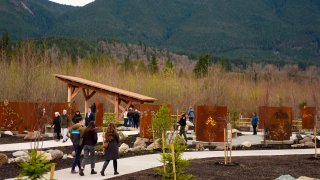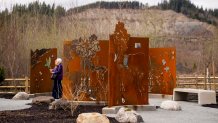
The small community of Oso, Washington, on Friday inaugurated a memorial honoring the 43 people killed at the site 10 years ago in the deadliest landslide in U.S. history.
Hundreds gathered there for a ceremony at the 2-acre (8,000-square-meter) memorial. The a $3.8 million site northeast of Seattle was dedicated to Oso, those who died there, the survivors and the first responders.
Tim Ward's wife Brandy and four of their dogs died, and their home was decimated when the slide struck that day. Ward previously described regaining consciousness 500 yards (457 meters) from where his house once stood, in a hole 15 feet (4.6 meters) deep, with an opening at the top the size of a kitchen saucer. Rescuers eventually pulled him out.
On Friday, he recalled the tight-knit community that shared what they had, describing friendly neighbors who put out extra produce for free when they had it.

“It was there for the taking. That’s who we were," Ward said. “That’s who we’re honoring. Remember the love and the compassion, from now until eternity. That’s how the neighborhood was.”
Many of the victims — retirees, grandparents, military veterans, office workers, young families — were at home that day. Others just happened to be there, including three contractors working on a house, someone installing a satellite TV dish, and a plumber servicing a hot-water tank.
U.S. & World
The day's top national and international news.
An estimated 19 million tons of sand and ancient glacial deposits — enough to cover 700 football fields 10 feet (3 meters) deep — slid at 10:37 a.m. on March 22, 2014. The mass of earth raced across the river at an average speed of 40 mph (64 kph), hydroplaning on the saturated valley floor before slamming into Steelhead Haven, a subdivision of 35 homes. The highway running alongside was buried 20 feet (6.1 meters) deep.
Nine people survived the slide, including a mother and a baby. Meanwhile, hundreds of responders spent days digging through rubble searching for victims. The last victim was recovered that July.

The slide was a national wake-up call about the dangers of landslides. Washington state hired more staff and conducted more mapping to get a better handle on the risk, and it tightened guidelines on logging landslide-prone slopes amid concerns that clearcutting near the top of the scar might have helped cause the disaster.
Congress in 2020 adopted the National Landslides Preparedness Act to create a national strategy to identify, understand and protect against landslides — legislation pushed by lawmakers from Washington state.



